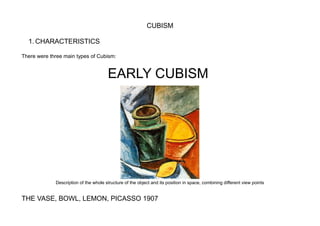Tarea material 2 corregido
- 1. CUBISM 1. CHARACTERISTICS There were three main types of Cubism: EARLY CUBISM Description of the whole structure of the object and its position in space, combining different view points THE VASE, BOWL, LEMON, PICASSO 1907
- 2. ANALYTICAL CUBISM The first stage of the Cubism movement was called Analytical Cubism. In this style, artists would study (or analyze) the subject and break it up into different blocks. They would look at the blocks from different angles. CLARINET AND BOTTLE OF RUM ON A MANTELPIECE BRAQUE, 1911
- 3. SYNTHETIC CUBISM The second stage of Cubism introduced the idea of adding in other materials in a collage. Artists would use colored paper, newspapers, and other materials to represent the different blocks of the subject. This stage also introduced brighter colors and a lighter mood to the art. BOTTLE, GLASS, GUITAR AND NEWSPAPER, PICASSO, 1913.WEBGRAFIA:




